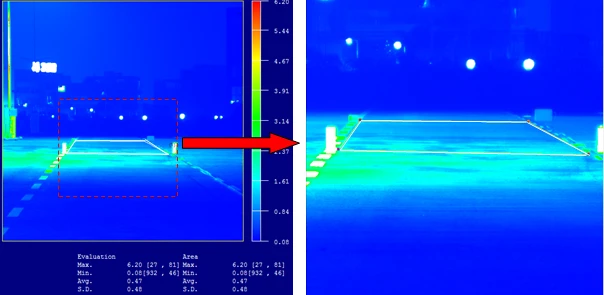Road Lighting Measurement Using Imaging Photometer

In street lighting, LED is an alternative to traditional lamp sources such as high intensity discharge lamps and high pressure sodium luminaires.
Light emitting diode (LED) technology is revolutionising functional outdoor lighting and in street lighting, LED is an alternative to traditional lamp sources such as high intensity discharge lamps and high pressure sodium luminaires. To quantify the performance of LED street lighting options, lighting specifiers must compare the claimed benefits of LED fixture such as long life, reduced maintenance and energy savings, to traditional light sources.
Most common road lighting calculation methods have been based on international standards CIE 140 published in 2000. Road lighting for main roads is normally specified using the following parameters:
- 1. Average road surface luminance (Lav)
- 2. Overall road surface luminance uniformity (UO)
- 3. Longitudinal road surface luminance uniformity (UL)
- 4. Threshold increment (TI%)
- 5. Surround ratio (SR)
Road lighting measurements (ie. Lav, Uo, UL) are conventionally done with spot luminance meters, such as Konica Minolta Luminance Meter LS-100. The use of spot luminance meters, however, leads to long set-up and measurement time caused by the large numbers of measurement points (≥ 30 points) distributed across the measurement field as required by the measurement standard. To enable the measurement to be carried out without the influence of vehicle headlamps, road closure (including the opposite lanes, if any) for several hours is needed. This will lead to traffic disruption and cost.
Certain road surface luminance details in between measurement points (caused by wearing and weather conditions) may not have been taken into account using the above-mentioned spot method. Hence, the actual maximum and minimum road surface luminance and the subsequent average and uniformity analysis may not be representative of the actual road condition.
With the technological advancement in optical and imaging technology, it is now possible to use an imaging photometer, such as Konica Minolta 2D Color Analyser CA-2500, instead of a spot photometer for road lighting measurement. A 2D imaging photometer using high resolution CCD sensor is able to measure luminance distribution for the entire road surface area instead of just luminance of predefined points, thus providing more comprehensive information for the analysis of road lighting performance in a shorter time.
The set-up and measurement time required for road lighting measurement with an imaging photometer is also much shorter as compared to conventional spot photometer as the imaging photometer captures the luminance distribution of the entire road surface area in just a few seconds. Hence, the road closures can be largely reduced.
For more information, please click 2D Color Analyser CA-2500 and Luminance Meter LS-150. Alternatively, feel free to contact us at +65 6895 8685 or drop us an email at ssg@gcp.konicaminolta.com to find out more from our color team on the product capabilities or to have a no-obligation discussion with our application advisors to help you select the appropriate models for your specific application.

The ability for imaging photometer to measure luminance distribution for the entire visual field, including the road surroundings and any targets in the visual field, also opens up new possibilities in analysing road lighting and its influence on drivers in future.
Konica Minolta offers a wide range spot photometer and imaging photometer for road lighting measurement. For more information on light measuring instruments, please visit Konica Minolta website at https://sensing.konicaminolta.asia/light-measurement/
References:
1) CIE Commission Internationale de l’Éclairage, 2000, Road Lighting Calculations, Publication No. 140.
2) Study report on “Road Surface Luminance Distribution Measurement by Imaging Photometer” made jointly by Guangdong Provincial Quality Supervision and Inspection Centre (Dongguan branch) and Konica Minolta in 2011.

